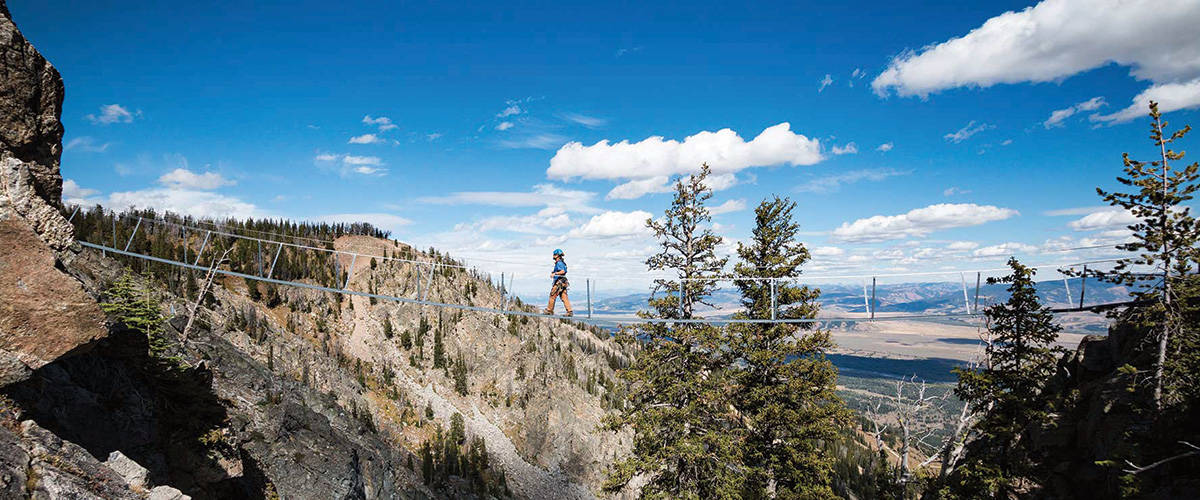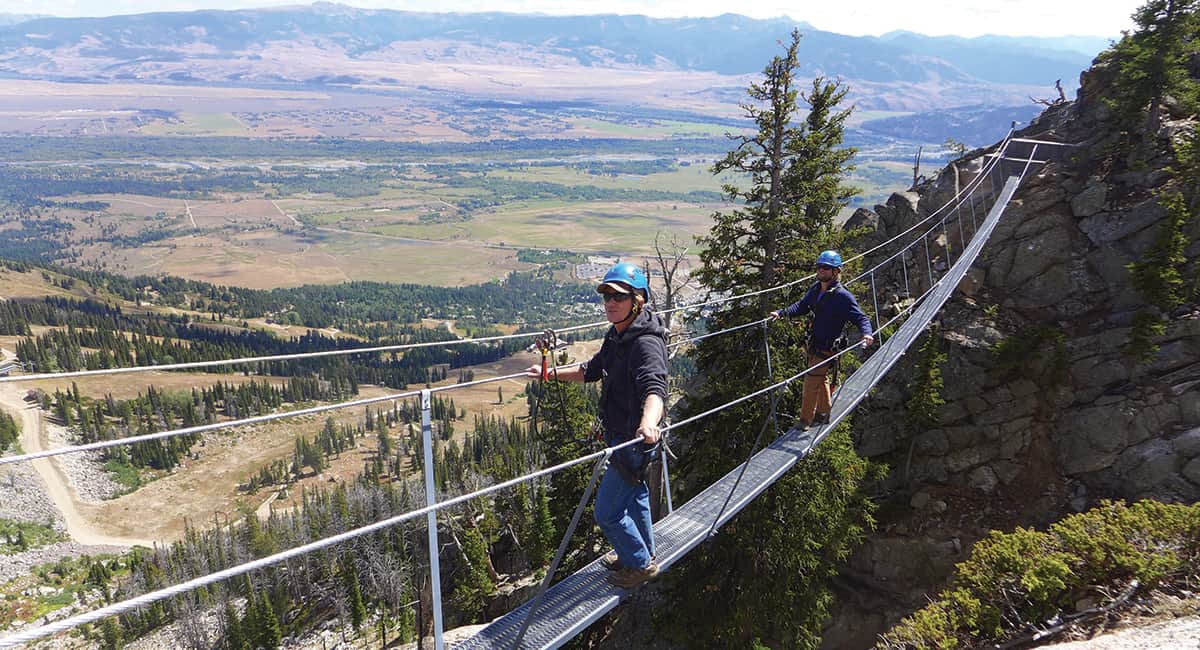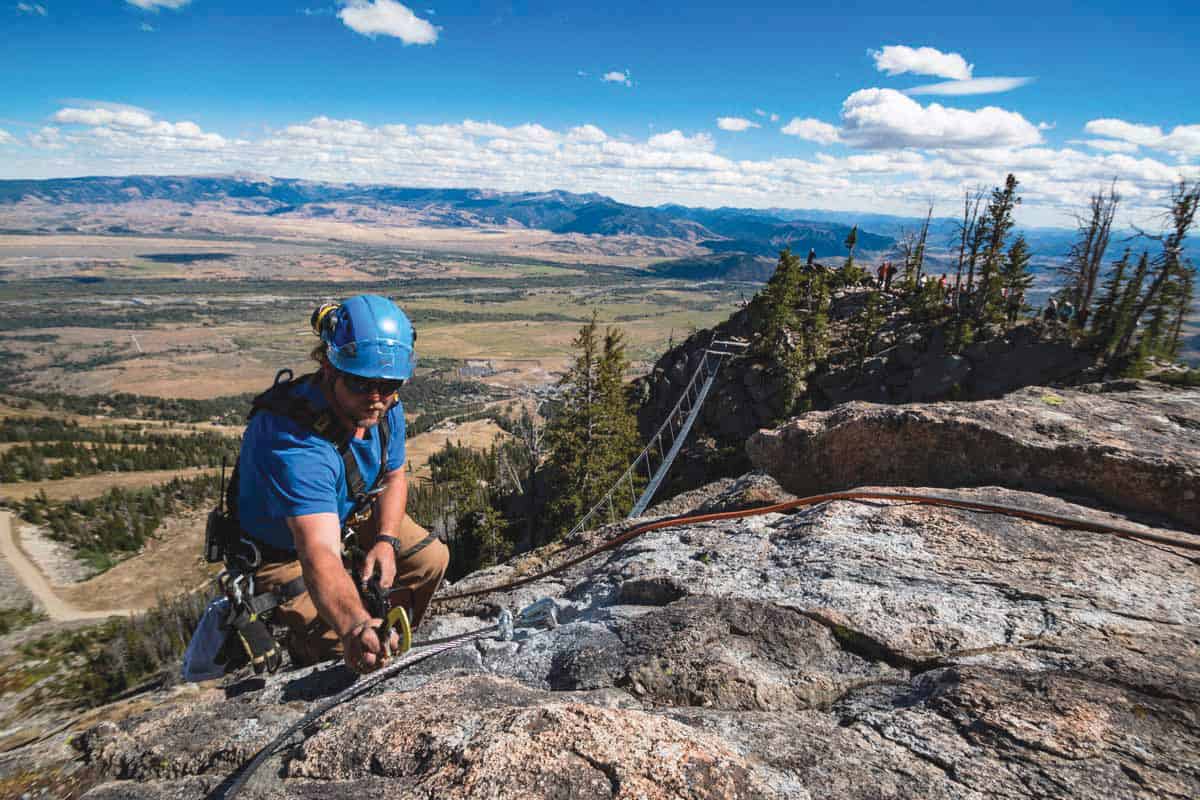Read The
Current Issue
Climb On
Jackson Hole Mountain Resort has been working with the U.S. Forest Service for nearly ten years to build assisted climbing routes at the resort. They finally open this summer.
BY Dina Mishev

“IT’S LIKE THAT scene in the Indiana Jones film where he has to step out and all he sees is a great chasm below,” says Mike Friedman about the 110-foot suspension bridge near the end of one of the new via ferrata climbing routes at Jackson Hole Mountain Resort (JHMR). “This bridge isn’t invisible, like the Indiana Jones one, and it is totally safe, but it requires a level of commitment.” The bridge hangs over an eighty-foot-deep chasm. “The sense of accomplishment when you get across it is high,” Friedman says.
This bridge is only one of the many manmade elements built into four new climbing routes on the steep granite walls immediately behind the top of the Bridger Gondola at more than 9,000 feet in elevation. The routes are all via ferrata—Italian for “iron way.” This type of assisted climbing has its origins in World War I when it was developed to help troops move through terrain they otherwise wouldn’t have been able to. Routes include bolts, iron rungs, and strands of cable affixed to vertical rock. The rungs are made from rebar glued into holes drilled into the rock. There are more than 1,000 of these climbs in Europe.
To climb a via ferrata (pl., vie ferrate), you have the natural features of the rock to stand on and hold onto, and also the rungs. To keep you from falling off the rock, you use special equipment to attach yourself to a cable that parallels the route. “This will be many people’s Grand Teton ascent,” says Friedman, a former climbing guide with Exum Mountain Guides and co-founder of Adventure Partners, which built five via ferrata routes at Amangiri resort near Page, Arizona. “It’s their moment to feel what it’s like to be a climber.”
“It’s like that scene in the Indiana Jones film where he has to step out and all he sees is a great chasm below.”
– Mike Friedman, Adventure partners co-founder
CONNIE KEMMERER, WHO owns JHMR with her brother, Jay, and sister, Betty, spearheaded the effort to install the vie ferrate at JHMR. “My interest goes back fifteen years, to a hiking trip I was taking in the Italian Dolomites. I saw these people up on a mountain climbing, but not totally climbing. I asked the guide what they were doing, and they were doing a via ferrata, which I had never heard of,” she says. “We got on some eventually. In our group there were people who had climbed, who hadn’t climbed, and who were even afraid of heights. We could all do it, and we all had fun.”
Making vie ferrate a reality at JHMR took so long because they are the very first ones on public land in this country. There are a handful of others in the U.S., but they are all on private land, where the owners don’t need to go through steps like establishing uniform engineering and safety standards, which are required when the U.S. Forest Service (USFS) owns the land. JHMR worked closely with the forest service to develop and then engineer and design their vie ferrate to standards that can now be followed by other groups interested in building them on USFS land. (JHMR isn’t worried that now that they’ve done all the groundwork other ski areas are going to jump onto the via ferrata bandwagon, lessening the uniqueness of its new adventure. “You have to have the goods,” Friedman says.)
“IT ONLY MAKES sense that Jackson would be the home of the first via ferrata,” Friedman says. “It is special because the Tetons are the home of American mountaineering. We hope this activity communicates a little bit of that story.” Vie ferrate can communicate this story to a wider range of people than merely rock climbers and mountaineers.
“It puts the nonclimber into a climbing situation that is safe as long as you obey the rules,” says Renny Jackson, a former climbing ranger in Grand Teton National Park, a guide with Exum, a JHMR ski patroller, and one of the few people to get to climb any of the vie ferrate when they were finished last fall. “You’re in the alpine realm without having to be a climber. You’re climbing with the help of these artificial installations, but the feeling is much the same.” Jackson says he can see the via ferrata experience promoting interest in going further and trying rock climbing. “People might get up there and think, ‘This is pretty cool. What would it be like to learn a little more about climbing and go somewhere without rungs?’ ”
Or maybe not. “We have courses designed for people who this might be their first and last time getting on rock,” says Jessica Milligan, vice president of product sales and service at JHMR. All via ferrata adventures begin on a practice area immediately behind the Bridger Gondola. The idea is for guides to demonstrate the via ferrata kit—two carabiner-equipped lanyards each with shock-absorbing properties to absorb any forces generated if you fall—to climbers, and for climbers to get comfortable with using it here. “Some people will probably have enough of an adventure on the practice area,” Milligan says.
For climbers who want more, there are two vie ferrate, each with about 450 feet of cable, above the gondola. Near the top of Ridgeline is the 110-foot suspension bridge. “The bridge is certainly fairly spectacular,” Jackson says. Friedman says the bridge was designed “to have a little bounce and life in it. Most people going across will have a firm grip on the safety line.” Four people are allowed on the bridge at any one time, but the bridge is strong enough to hold sixty people. “It’s a very high level of safety we have in everything,” Friedman says.
But the bridge isn’t the end of the Ridgeline, which is rated as intermediate. “What’s really cool about this bridge is that it ends with a via ferrata. You have to climb some rungs to get out of it,” Friedman says. “Vie ferrate are a European thing, and we haven’t dumbed it down just because it’s in America. We’ve stayed true to the mountaineering culture.”
JHMR’s vie ferrate are doubly European, because drinks and appetizers are only a short walk from its base, at The Deck and Piste.
Nuts & Bolts
JHMR’s vie ferrate are not accessible without a resort guide. Experiences start at $109 per person (ages 12 and up) with a maximum group size of four. Ten- and eleven-year- olds may be allowed to do the vie ferrate if a guide finds that they have the listening ability. These ages always climb the course on belay and must have their own guide, which starts at $120. Hire a private guide for a full day for $469 for two people. Prices include all gear and lunch. Reservations required. 307/739-2779, jacksonhole.com






